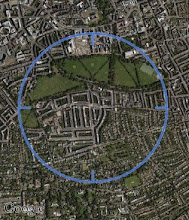The meeting was held at the Church of the German Speaking Congregation on Tu 13 Sep starting at 19:30
Douglas Rogers welcomed around 100 people to the meeting and outlined the Agenda. Alastair Philp added his welcome on behalf of the Marchmont & Sciennes Community Council. Ian Murray MP and Miles Briggs MSP had sent apologies. Daniel Johnson MSP and Cllr Steve Burgess were present, and Cllr Cameron Rose arrived during the meeting.
David Wood from PAS (Planning Aid for Scotland) gave a short introduction to PAS, which provides impartial advice and training on the planning process for local communities. He also spoke about how community engagement in planning can be assisted by the use of 'Charrettes' and described PAS’s Charretteplus approach. The 'Charrette' process uses intensive community-design workshops to develop a shared vision.
Charles Campion from JTP then spoke. He outlined how the 'Charrette' process (including site visit, drop-ins and 2 days of workshops) had been used for redevelopment of a former hospital site in London. Experts had facilitated the process and when the eventual planning application was considered by the Planning Committee it was passed unanimously.
Douglas Rogers welcomed around 100 people to the meeting and outlined the Agenda. Alastair Philp added his welcome on behalf of the Marchmont & Sciennes Community Council. Ian Murray MP and Miles Briggs MSP had sent apologies. Daniel Johnson MSP and Cllr Steve Burgess were present, and Cllr Cameron Rose arrived during the meeting.
David Wood from PAS (Planning Aid for Scotland) gave a short introduction to PAS, which provides impartial advice and training on the planning process for local communities. He also spoke about how community engagement in planning can be assisted by the use of 'Charrettes' and described PAS’s Charretteplus approach. The 'Charrette' process uses intensive community-design workshops to develop a shared vision.
Charles Campion from JTP then spoke. He outlined how the 'Charrette' process (including site visit, drop-ins and 2 days of workshops) had been used for redevelopment of a former hospital site in London. Experts had facilitated the process and when the eventual planning application was considered by the Planning Committee it was passed unanimously.
Stewart Adams from NHS Lothian then explained the approach to be taken in selling the RHSC site. The site will be marketed now (as a single site) with initial offers invited by Christmas, and final offers early in 2017. A developer will then be selected, and they will continue the planning process. Community Engagement is starting now, with this meeting, and will continue, involving the developer when one is chosen.
Richard Slipper, from GVA James Barr (acting as planning consultant for NHS Lothian) shared the proposed plan for pre-planning activities. He is compiling a 'position statement' that will summarise relevant planning 'facts' including what the local development plan says, constraints on the site due to listed buildings and the site being in a conservation area. This 'position statement' will also include initial community views: to gather these there will be a public workshop in November (date to be set; involving local groups including MSCC). The 'position statement' will help to develop a list of criteria that can be used as part of the developer selection process.
Laura Bird from Sciennes Primary Parent Council asked that the planning and engagement process considers how more playground space could be found for the school. Perhaps by limiting traffic on Sciennes Road in front of the school to pedestrians and cyclists and enlarging the existing community woodland strip.
Elizabeth Cumming from the Mansfield Traquair Trust spoke about the Phoebe Traquair murals (picture 1 and picture 2) on the site in the current mortuary. These are class A listed. Some are painted directly onto lathe and plaster but some were moved to the site from another location in 1894 and are deliberately embedded in boxes. The murals are fragile and must be protected during construction. National Museums of Scotland would help with any fund raising.
Then Stuart Irvin, the Minister at St Catherine's Argyle asked us to consider, as we ponder redevelopment options, the fact that the hospital has been the site of many personal tragedies as well as triumphs. He also made a plea for affordable housing to ensure a rich mix of ages of resident.
The meeting concluded with a question and answer session, including:
- There was concern that a developer might not take notice of community views. Hard to predict until they are chosen.
- Could affordable housing be constructed that is externally indistinguishable from 'posh flats'
- Daniel Johnson MSP asked if NHS Lothian would fund a Charrette process. They have no current plans to do full 'Charrette' but would engage if a planned funding application to Scottish Government is successful. They do commit to a 3 hour workshop in November. In a quick poll of the meeting most said they'd like to take part in a 'Charrette' process if there was one.
- Could there be a stipulation on chosen developer to run a 'Charrette' process? This is in theory possible but would have to be paid for from proceeds of sale. It was pointed out (by Charles Campion) that a 'Charrette' can save a developer money if it smooths passage of the planning application.
- Could developer be compelled to leave public space? Always a balance between routes through a site and resident's privacy.
- Could there be 'meanwhile uses' if the site is vacant? Intention is for developer to develop as soon as NHS Lothian vacate (in spring/summer 2018) but could perhaps be considered by developer if there's a delay.
- Could property be transferred from NHS Lothian to City of Edinburgh Council for Sciennes School? NHS Lothian need to maximise money they make from sale on behalf of Scottish Government who get the money from the half of the site they own [the other half is owned by the Edinburgh & Lothians Health Foundation who have agreed a joint sale with NHS Lothian].



No comments:
Post a Comment